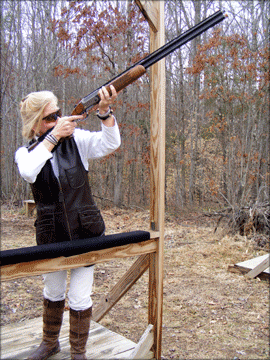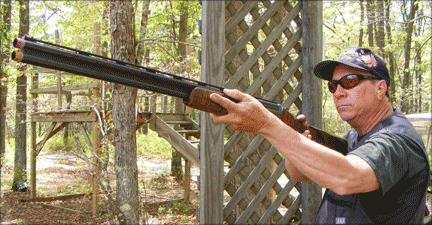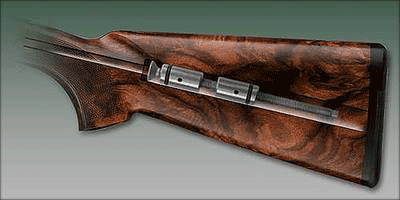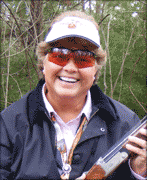Peer Review: The Blaser F3 28-Gauge Over/Under
Written by Irwin Greenstein with the opinions of Stephen Biello, Debbie Clay, Barry Goff, Sr., Brad Landseadel, Elizabeth Lanier, Joe Notarfrancesco , Vero Ricci, Steve Toomey, Kent Witters, Carolinn Poucher Woody
After Elizabeth Lanier finished shooting five stand with Blaser’s 28-gauge F3, her immediate response was “I think that maybe Blasers aren’t given the kudos they deserve.”
And you know what? We agree with her.
While Team Blaser shooters have accumulated trophies in the U.S. Open, the Sporting Nationals and the Texas State Shoot, and Blaser is a popular corporate sponsor of sanctioned competitions across the U.S., the German shotgun and rifle maker eludes most American shooters –except for the cognoscenti who prize cutting-edge engineering in their over/unders.
Pronounced Blah-zer, the 28-gauge F3 drives home the point that Blaser has not quite yet reached the tipping point for recreational shooters in search of high-quality, mid-priced shotguns. Part of the reason may be that Blasers have been coming into the U.S. only since 2005 – a relative newbie compared to Beretta, Krieghoff, Browning and other staples of the American shotgun scene.

But the Shotgun Life Peer Review Posse clearly demonstrated that once you shoot a 28-gauge F3, you’ll want to own one.
As Steve Toomey said after shooting sporting clays with the 28-gauge F3, “I’d buy that gun in a minute. I loved that gun.”
And Joe Notarfrancesco commented after some sporting clays, “That would be the gun I’d give up my 12 gauge for. That’s how enjoyable it was to shoot.”

If you haven’t shot a Blaser yet, we’re here to tell you that the ergonomics, balance and performance of the 28-gauge F3 make the shotgun stand out through its complete lack of drama. Rather than whippy, it proved controllable. Instead of a youth-gun feel, Blaser’s 28 gauge exerted the grace and heft of a svelte 12-gauge sporter.
When some members of the Peer Review Posse noted that the F3 felt bigger than what you’d expect from a 28 gauge, this wasn’t meant as a slam. Instead, nearly everyone shared the opinion that the 28-gauge F3 possessed the poise and self-assurance associated with a quality 12- gauge such as Krieghoff, Perazzi or Kolar.

And there’s a good reason for this shared perception…
Unlike most shotgun manufacturers who have two or three different size receivers to accommodate a full range of gauges, Blaser has only one receiver. To maintain a consistent shooting experience, all of its barrels, regardless of gauge and length, weigh 3½ pounds and fit into the CNC-machined receiver – bringing total weight to between 8 and 8¼ pounds (the weight difference can also depend on wood density).
With barrels now available in 12, 20 and 28 gauge, the beauty of this ingenious approach is that you never have to reacquaint yourself with the gun, or reacclimatize to the weight and swing dynamics when shooting with sub-gauge tubes.
It makes you wonder why no one else has adopted this paradigm for building shotguns.
If you think of simplicity as a 21st century virtue, the standard F3’s aesthetic sets the bar for its clean yet purposeful lines.
On a rack of shotguns, the Blaser’s ultra low profile receiver, smooth slate-gray finish and matte-black barrels stand out as remarkably elegant and unpretentious, while conveying an unrivaled competence and precision. The F3 could easily come out of a Silicon Valley design studio instead of Blaser’s headquarters in Isny im Allgau, Germany – a country typically associated with the deep-relief style of firearms engraving called Federstich.

Given our druthers we would opt for the standard-grade shotgun simply because we are so taken with that grey satin receiver adorned only with “F3” in gold as complemented by the black barrels and other hardware including the trigger guard, top lever and hinge pin. The adjustable trigger is polished stainless steel. Add the wood, that on our gun featured smoky figuring contrasting between deep brown and honey gold, and you have the palette of an industrial loft conversion from Architectural Digest.
Higher grade models garnish the F3 receiver with progressively more ornamentation culminating with the full sideplate presentation of game, scroll and arabesque on the Imperial; and in fact this would be the way to go for lovers of fine engraving because the sideplates enhance the streamlined silhouette of the boxlock by elongating the receiver’s appearance. (Check out our story “The Most Expensive Blaser F3 in the World?”)
The slender receiver on the F3 results from engineering breakthroughs in the trigger group, ejectors and monobloc, which all contribute to the streamline dimensions. The receiver measures 2.415-inches high at its tallest point, making it one of the lowest profile guns we’ve handled.

The monobloc is the cornerstone for the low profile. A 0.842-inch-wide, 0.746-inch-long underlump protrudes into a recess in the bottom of the receiver, placing it flush with the bottom when the action is closed where it’s locked down with a full-width bolt.
The in-line hammers on the mechanical triggers perform like rocket sleds on the firing pins. Positioned directly over the trigger group, in exact alignment with the bores of the barrels, the F3’s in-line hammers also allow for a lower profile by eliminating taller cam-shaped hammers. Another low-profile over/under, the Browning Cynergy, employs a similar striker design for its mechanical trigger. Having shot both, however, I can clearly say that the F3 is smoother in every way, from the feel of the action to the impeccable fit between the monobloc and hinge pins.
Given Blaser’s engineering philosophy, it made sense that the F3 has mechanical triggers. They are inherently more reliable than the inertia triggers that continue to dominate the shotgun world. Inertia triggers rely on the kick from the first shot to engage the sear mechanism of the second, unfired barrel. If you accidentally hold the gun away from your shoulder, or if your first shell is a poofer, the second shot is less likely to fire. By contrast, mechanical triggers operate independently of each other, like a side by side with two triggers. Now imagine a buttery 3.3-pound pull on the perfectly contoured Blaser trigger and you can appreciate the wonder of shooting it.

Better yet, Blaser’s IBS (Inertial Blocking System) prevents the involuntary second pull of the trigger (or fan firing) that you can find on single trigger guns. It’s just the kind of shock that can make you trade in your trusty, old shotgun for an F3.
With the F3, that struggle to wrestle open your new over/under has gone the way of the carburetor courtesy of Blaser’s Ejector Ball System, which is covered by some 10 patents. The arrangement cocks the ejectors upon firing instead of opening, relieving the pressure on the F3 ejector springs for easier opening – its effortlessness on par with some of the six-figure Best Guns coming out of England.
The barrel selector is inside the trigger guard. When the button is in the back position, the bottom barrel is selected.
Blaser’s barrels come in 28, 30 and 32 inches, as we mentioned the barrels all weigh the same and are interchangeable with the receiver. The barrels will accommodate 3-inch cartridges. They are chrome-plated and magnum proofed for steel. They also pack flat forcing cones and a backboring to 0.733 inches on the 12-gauge model. Side ribs contribute to the structural integrity of the barrels and the rib is vented. Each Blaser comes with a full set of extended, color-coded Briley chokes.
The result of this advanced barrel engineering is a 28 gauge that throws stunning patterns.
“I hit a 40-yard target solid with it so it patterned beautifully,” said Shotgun Life Posse member
Brad Landseadel while on the five-stand course.

At the other end of the shotgun, the stock contains a balancer that regulates the weight of the buttstock with a weight cylinder.
The sum of the parts on the 28-gauge F3 is a highly controllable shotgun. The synergy of the palm swell and pistol grip ensured an exceptional level of confidence in the pointability. Likewise, the tapered Prince of Wales forend rested comfortably in my left hand for marvelous handling on fast crossers.
The trigger revealed zero creep, conveying a sense of “mission accomplished” after each shot.
While Brad attributed his 40-yard hit to the excellent patterning, my own testimonial is a broken 60-yard teal with No. 9 shot through a light-mod choke in the bottom barrel.
The 28-gauge Standard F3 we shot was priced at $6,895. A set of 28-gauge barrels for your F3 will cost $2,733.
There are some people, like me, who believe that the 28-gauge is the perfect shotgun bore. If you also fall into that group, the F3 will spoil you for good.
Now let’s hear from the Shotgun Life Peer Review Posse on Blaser’s 28-gauge F3…

Steven Biello
Profession: Law Enforcement
Gun of Choice: Browning 525 Sporting
- Aesthetically, I liked the way it looked.
- It just had a real good feel about it.
- The ejectors were the most powerful I’ve ever seen. Those shells are coming out.
- It looked like a quality gun, but I wouldn’t be afraid to take it out into the field.
- Really nice triggers…no drag whatsoever. It was really nice to shoot.
- It was a smooth swinging gun.

Debbie Clay
Profession: Nurse
Gun of Choice: Browning 625
- I really, really liked it.
- I liked how the gun felt, it was well-balanced and it felt good on my shoulder. It felt good in a woman’s hand and the pistol grip was comfortable.
- It pointed excellent.

Barry Goff, Sr.
Profession: Retired
Gun of Choice: Krieghoff K-80
- The gun fit me well.
- It had a good heft to it for a 28 gauge.
- It had a nice, crisp trigger.

Brad Landseadel
Profession: NSCA Instructor and Owner of Central Virginia Sporting Clays
Gun of Choice: Beretta DT10
- I hit a 40-yard target solid with it so it patterned beautifully.
- It seems well-constructed and solid. It was nice and tight.
- In my mind, when the gun was in the right place I automatically pulled the trigger, meaning that it was a very intuitive trigger.

Elizabeth Lanier
Profession: NSCA Instructor
Gun of Choice: Perazzi MX8
- Beautifully balanced.
- Very well made.
- To appeal to a woman’s market it needs a Monte Carlo stock or an adjustable comb.
- It’s a sweet gun.

Joe Notarfrancesco
Profession: Police Officer
Gun of Choice: Browning Golden Clays
- In terms of fit, the pull was a little short for me.
- That would be the gun I’d give up my 12 gauge for. That’s how enjoyable it was to shoot.
- I liked the matte grey receiver.
- The trigger was smooth and crisp.
- The ejectors were phenomenal.
- It swung very, very smooth.
- The weight of it…that gun would not tire you out.
- It had negligible recoil.

Vero Ricci
Profession: Retired Industrial Designer
Gun of Choice: Beretta 390 and Browning Sweet 16
- I liked everything about it.
- The barrels were slightly heavy and I would need time to adjust to it.
- You don’t realize you’re shooting a 28 gauge when a gun fits that well.
- The machining on that 28 gauge was marvelous.
- The wood-to-metal finish was magnificent.
- It was a delight to shoot. I’d buy one tomorrow.

Steve Toomey
Profession: Construction Inspector
Gun of Choice: Remington 1100
- I’d buy that gun in a minute. I loved that gun.
- It was well-balanced.
- It went right to the target.
- It had a nice trigger.

Kent Witters
Profession: Sales Engineeer, Scientific Instrumentation
Gun of Choice: Beretta 391
- It fit me perfectly fine.
- As far as the workmanship, I really liked it.
- I liked the looks of the receiver.
- It has a palm swell that fits real good.
- Recoil was minimal because of the weight of the gun and relatively wide stock.

Carolinn Pocher Woody
Profession: Publishing Consultant
Gun of Choice: Caesar Guerini Maxum
- It had a very crisp trigger
- The barrel weight made it feel like a 12 gauge.
- It was a very smooth-shooting gun.
- The detailing was very nice.
Irwin Greenstein is the publisher of Shotgun Life. Please send your comments and questions to letters@shotgunlife.com.
Helpful resources:

Irwin Greenstein is Publisher of Shotgun Life. Please send your comments to letters@shotgunlife.com.


Comments